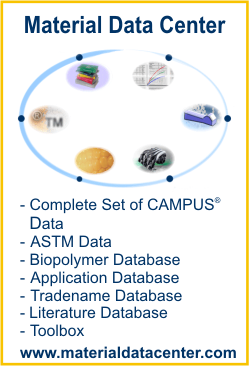Material Data Center is a leading international information system for the plastics industry. Material Data Center offers a comprehensive plastics database, calculation tools, CAE interfaces, a literature database and an application database. For more information about Material Data Center visit www.materialdatacenter.com.
This is the free Material Data Center Datasheet of VANDAR® 2100UV - PBT - Celanese
unit conversion, PDF datasheet print, comparison with other plastics, snap fit calculation, beam deflection calculation, CAE Interfaces
Check here, which other Vandar datasheets, application examples or technical articles are available in Material Data Center
| Flammability at thickness h (1.6 mm) | HB | - |
| Caracteristicas de procesamiento y fisicas | Valor | Unidades | Método de ensayo | ||||||||||||||||||||||||||||||||||||||||||||||||||||||||||||||||||||||||||||||||||||||||||||||||
| ISO Data | |||||||||||||||||||||||||||||||||||||||||||||||||||||||||||||||||||||||||||||||||||||||||||||||||||
| Indice de fluidez volumétrico, MVR | 5.5 | cm³/10min | ISO 1133 | ||||||||||||||||||||||||||||||||||||||||||||||||||||||||||||||||||||||||||||||||||||||||||||||||
| Temperatura | 250 | °C | - | ||||||||||||||||||||||||||||||||||||||||||||||||||||||||||||||||||||||||||||||||||||||||||||||||
| Carga | 5 | kg | - | ||||||||||||||||||||||||||||||||||||||||||||||||||||||||||||||||||||||||||||||||||||||||||||||||
| Contracción posterior al moldeo, paralelo | 1.9 | % | ISO 294-4, 2577 | ||||||||||||||||||||||||||||||||||||||||||||||||||||||||||||||||||||||||||||||||||||||||||||||||
| Contracción posterior al moldeo, normal | 1.9 | % | ISO 294-4, 2577 | ||||||||||||||||||||||||||||||||||||||||||||||||||||||||||||||||||||||||||||||||||||||||||||||||
| Propiedades mecánicas | Valor | Unidades | Método de ensayo | ||||||||||||||||||||||||||||||||||||||||||||||||||||||||||||||||||||||||||||||||||||||||||||||||
| ISO Data | |||||||||||||||||||||||||||||||||||||||||||||||||||||||||||||||||||||||||||||||||||||||||||||||||||
| Módulo de tracción | 1750 | MPa | ISO 527 | ||||||||||||||||||||||||||||||||||||||||||||||||||||||||||||||||||||||||||||||||||||||||||||||||
| Esfuerzo de fluencia | 38 | MPa | ISO 527 | ||||||||||||||||||||||||||||||||||||||||||||||||||||||||||||||||||||||||||||||||||||||||||||||||
| Alarg. en límite elástico | 4.4 | % | ISO 527 | ||||||||||||||||||||||||||||||||||||||||||||||||||||||||||||||||||||||||||||||||||||||||||||||||
| Alarg. nominal a rotura | >50 | % | ISO 527 | ||||||||||||||||||||||||||||||||||||||||||||||||||||||||||||||||||||||||||||||||||||||||||||||||
| Resistencia al impacto Charpy, +23°C | N | kJ/m² | ISO 179/1eU | ||||||||||||||||||||||||||||||||||||||||||||||||||||||||||||||||||||||||||||||||||||||||||||||||
| Resistencia al impacto Charpy, -30°C | N | kJ/m² | ISO 179/1eU | ||||||||||||||||||||||||||||||||||||||||||||||||||||||||||||||||||||||||||||||||||||||||||||||||
| Resistencia al impacto Charpy c/entalla, +23°C | 80 | kJ/m² | ISO 179/1eA | ||||||||||||||||||||||||||||||||||||||||||||||||||||||||||||||||||||||||||||||||||||||||||||||||
| Resistencia al impacto Charpy c/entalla, -30°C | 19 | kJ/m² | ISO 179/1eA | ||||||||||||||||||||||||||||||||||||||||||||||||||||||||||||||||||||||||||||||||||||||||||||||||
| Propiedades térmicas | Valor | Unidades | Método de ensayo | ||||||||||||||||||||||||||||||||||||||||||||||||||||||||||||||||||||||||||||||||||||||||||||||||
| ISO Data | |||||||||||||||||||||||||||||||||||||||||||||||||||||||||||||||||||||||||||||||||||||||||||||||||||
| Temperatura de fusión, 10°C/min | 225 | °C | ISO 11357-1/-3 | ||||||||||||||||||||||||||||||||||||||||||||||||||||||||||||||||||||||||||||||||||||||||||||||||
| Temp. de transición vítrea, 10°C/min | 60 | °C | ISO 11357-1/-2 | ||||||||||||||||||||||||||||||||||||||||||||||||||||||||||||||||||||||||||||||||||||||||||||||||
| Estabilidad al calor, 1.80 MPa | 51 | °C | ISO 75-1/-2 | ||||||||||||||||||||||||||||||||||||||||||||||||||||||||||||||||||||||||||||||||||||||||||||||||
| Estabilidad al calor, 0.45 MPa | 86 | °C | ISO 75-1/-2 | ||||||||||||||||||||||||||||||||||||||||||||||||||||||||||||||||||||||||||||||||||||||||||||||||
| Temp. reblandecimiento Vicat, B | 128 | °C | ISO 306 | ||||||||||||||||||||||||||||||||||||||||||||||||||||||||||||||||||||||||||||||||||||||||||||||||
| Coef.de expansión térmica lineal, paralelo | 130 | E-6/K | ISO 11359-1/-2 | ||||||||||||||||||||||||||||||||||||||||||||||||||||||||||||||||||||||||||||||||||||||||||||||||
| Combustibilidad a espesor h | HB | class | IEC 60695-11-10 | ||||||||||||||||||||||||||||||||||||||||||||||||||||||||||||||||||||||||||||||||||||||||||||||||
| Espesores de probeta | 1.6 | mm | - | ||||||||||||||||||||||||||||||||||||||||||||||||||||||||||||||||||||||||||||||||||||||||||||||||
| Propiedades eléctricas | Valor | Unidades | Método de ensayo | ||||||||||||||||||||||||||||||||||||||||||||||||||||||||||||||||||||||||||||||||||||||||||||||||
| ISO Data | |||||||||||||||||||||||||||||||||||||||||||||||||||||||||||||||||||||||||||||||||||||||||||||||||||
| Constante dieléctrica, 100Hz | 4 | - | IEC 62631-2-1 | ||||||||||||||||||||||||||||||||||||||||||||||||||||||||||||||||||||||||||||||||||||||||||||||||
| Constante dieléctrica, 1MHz | 3.6 | - | IEC 62631-2-1 | ||||||||||||||||||||||||||||||||||||||||||||||||||||||||||||||||||||||||||||||||||||||||||||||||
| Factor de pérdidas dieléctricas, 100Hz | 70 | E-4 | IEC 62631-2-1 | ||||||||||||||||||||||||||||||||||||||||||||||||||||||||||||||||||||||||||||||||||||||||||||||||
| Factor de pérdidas dieléctricas, 1MHz | 200 | E-4 | IEC 62631-2-1 | ||||||||||||||||||||||||||||||||||||||||||||||||||||||||||||||||||||||||||||||||||||||||||||||||
| Resistividad volumétrica específica | 1E12 | Ohm*m | IEC 62631-3-1 | ||||||||||||||||||||||||||||||||||||||||||||||||||||||||||||||||||||||||||||||||||||||||||||||||
| Resistividad superficial específica | 1E14 | Ohm | IEC 62631-3-2 | ||||||||||||||||||||||||||||||||||||||||||||||||||||||||||||||||||||||||||||||||||||||||||||||||
| Resistencia dieléctrica | 24 | kV/mm | IEC 60243-1 | ||||||||||||||||||||||||||||||||||||||||||||||||||||||||||||||||||||||||||||||||||||||||||||||||
| Otras propiedades | Valor | Unidades | Método de ensayo |
| Absorción de agua | 0.45 | % | Sim. to ISO 62 |
| Absorción de humedad | 0.2 | % | Sim. to ISO 62 |
| Densidad | 1220 | kg/m³ | ISO 1183 |
Rear Temperature 450-480(230-250) deg F (deg C)
Center Temperature 460-490(235-255) deg F (deg C)
Front Temperature 470-500(240-260) deg F (deg C)
Nozzle Temperature 470-510(240-265) deg F (deg C)
Melt Temperature 470-510(240-265) deg F (deg C)
Mold Temperature 100-200(40-95 deg F (deg C)
Back Pressure 0-50 psi
Screw Speed Moderate
Injection Speed Fast
Injection speed, injection pressure and holding pressure have to be optimized to the individual article geometry. To avoid material degradation during processing low back pressure and minimum screw speed have to be used. Overheating of the material has to be avoided, in particular for flame retardant grades. Up to 25% clean and dry regrind may be used.
Material Data Center is provided by M-Base Engineering + Software GmbH. M-Base Engineering + Software GmbH assumes no liability for the system to be free of errors. Any decision about the application of materials must be double checked with the producer of this material.
Additional information about this material, like producer contact address, etc. can be found at www.materialdatacenter.com. For access to this extra information a registration is requested. Free online registration is available.













